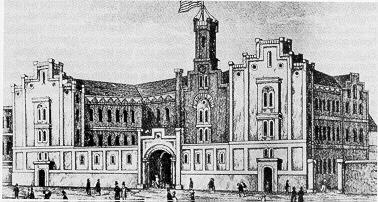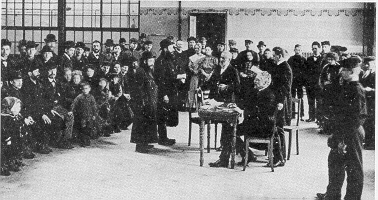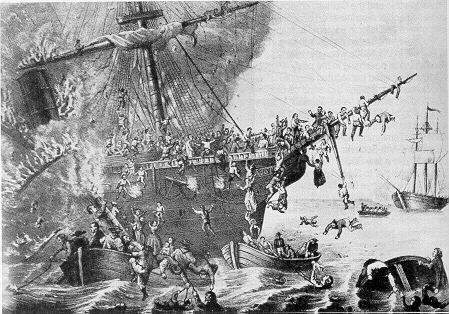




By far the largest number of German immigrants went to America in search
of an improved
standard of living. Political and religious freedom probably motivated
fewer emigrants than did
the threat of Prussian military service. Whether "push factors," fanned
by disgruntlement with
living conditions in Germany, or whether "pull factors" -- faith in more
favorable opportunities in
the United States -- exercised a greater influence on the emigrant's
decision to leave, is impossible to
ascertain. Table 1 shows widely varying
numbers of immigrants by year. This can best be
explained in terms of the interaction between push and pull factors in
the emigrant's homeland and
in the target country. At any rate, we do know that ever since the 18th
century, detailed
information about American business cycles, wages and food prices was
widely publicized in
Germany. Immigrant letters back home were read aloud in village taverns
and no doubt served to
correct some of the exaggerated claims made in the immigrant recruitment
literature distributed by
land companies and railroads.

In a broader sense, economic and political motivation cannot be separated. As a matter of fact, when the decision to emigrate was impelled by the desire to become a farmer with one's own land or a craftsman with one's own business, this also implied a rejection of the rigidity of the social class structure in the authoritarian German states. Thus, from his point of view, an official in the state of Nassau in 1846 was correct in complaining that "emigrants were infected with the disease of an erroneous concept of freedom and a monstrous idea about statehood," and that emigration fever was making the "lower class" rebellious. A clear renunciation of the ruling political class can be detected, for example, in the demands made by 160 tenant farmers [Heuerlinge] from the village of Engter near Osnabrück, a region of massive emigration. In a plea presented to the Duke of Braunschweig in the revolutionary year of 1848, they pressed for eight considerations:
Source: Osnabrücker Tageblatt, April 4, 1848. See also Kamphoefner, The Westphalians (1987), 62.
| Table 3. German Immigration since 1820 | |||
|---|---|---|---|
| Decade | Total Immigration | German | % of Total |
| 1820-29 | 128,502 | 5,753 | 4.5 |
| 1830-39 | 538,381 | 124,726 | 23.2 |
| 1840-49 | 1,427,337 | 385,434 | 27.0 |
| 1850-59 | 2,814,554 | 976,072 | 34.7 |
| 1860-69 | 2,081,261 | 723,734 | 34.8 |
| 1870-79 | 2,742,137 | 751,769 | 27.4 |
| 1880-89 | 5,248,568 | 1,445,181 | 27.5 |
| 1890-99 | 3,694,294 | 579,072 | 15.7 |
| 1900-09 | 8,202,388 | 328,722 | 4.0 |
| 1910-19 | 6,347,380 | 174,227 | 2.7 |
| 1920-29 | 4,295,510 | 386,634 | 9.0 |
| 1930-39 | 699,375 | 119,107 | 17.0 |
| 1940-49 | 856,608 | 117,506 | 14.0 |
| 1950-59 | 2,499,268 | 576,905 | 23.1 |
| 1960-69 | 3,213,749 | 209,616 | 6.5 |
| 1971-80 | 4,493,000 | 66,000 | 1.5 |
| 1981-88 | 4,711,000 | 55,800 | 1.2 |
| Totals | 49,753,412 | 7,028,258 | 14.1 |
[Source: U. S. Bureau of the Census, Historical Statistics of the United States: Colonial Times to 1970, Washington, D. C., 1975, 15; U. S. Bureau of the Census, Statistical Abstract of the United States: 1990, Washington, D. C., 10]

Religiously-motivated emigrant groups typically left the Old World in the 18th and early 19th centuries. In the intolerant environment of Europe, they had not been permitted to shape their own community life. Not just pietistic sects, but also members of recognized state churches, went through the trouble of emigration. In 1839, for example, over 1,000 Old Lutherans emigrated to evade the forced unification of the Lutheran and Reformed churches in Prussia. They went primarily to Buffalo, Milwaukee and St. Louis. Pietistic and Anabaptist groups founded "communistic" or communal societies, in Pennsylvania, among other places, both at Harmony in 1804 and at Economy in 1825, in Indiana in 1814 at New Harmony, at Zoar, Ohio in 1817, and at Amana, lowa in 1843. The number of Catholic emigrants, particularly of Catholic priests and members of religious orders, increased dramatically following Bismarck's Kulturkampf (1871 - 1887), the power struggle between the Prussian state and the Catholic church. Jews fled social discrimination especially in southern and later in eastern Germany.

Politically-motivated emigration began in earnest in the 1830s when the reactionary forces governing in the post-Napoleonic period persecuted liberals and democrats. Several thousand revolutionaries left after the failed German Revolution of 1848, most of whom at first considered themselves asylum seekers rather than emigrants. Likewise, Bismarck's Anti-Socialist Law (1878-90) caused quite a few Social Democratic activists to move to New York and Chicago to continue their class struggle. The next wave of politically-motivated emigrants consisted of groups marked for annihilation by the National Socialist dictatorship between 1933-45, among them Social Democrats and other opponents of the regime, and above all Jewish Germans and other Europeans threatened with mass murder and genocide. In the postwar era after 1945, when Germany lay in ruins, the traditional principal factor inducing emigration, namely economics, was back at work.
Economic conditions as well as political relationships differed greatly in the German regions during the 18th and 19th centuries. In southwestern Germany the inheritance laws played a major role, especially the division of the parental possessions among all children in equal shares, which resulted in the continued dismemberment of family farms. This problem was alleviated whenever factories were constructed in the neighborhood, with the result that additional workers were needed. Then emigration usually took a downturn. Such was the case for instance in the Ruhr district, in Saxony, and in Silesia as well as in greater Berlin.
On the other hand, in regions such as northwestern Germany, where the
firstborn enjoyed
priority when it came to an inheritance, a high rate of emigration still
might prevail. This happened
in the early
phases of the industrial revolution, when
 home spinning wheels fell idle because English cloth
goods came on the market at much lower prices. Those occupied in the
cottage industry of
Westphalia and
Osnabrück were particularly affected. As a result, many peasants of
this region left their homeland
during the 1830s and 40s.
home spinning wheels fell idle because English cloth
goods came on the market at much lower prices. Those occupied in the
cottage industry of
Westphalia and
Osnabrück were particularly affected. As a result, many peasants of
this region left their homeland
during the 1830s and 40s.
In addition, wheat crop failures, poor wine harvests and a potato blight made for more misery. Heavy emigration from the regions east of the Elbe River occurred in the last third of the 19th century. More and more, grain farms there lost out to the fertile soils of the American Midwest and its highly competitive products -- raised, ironically, on fields then being cultivated by immigrant farmers from northern Europe who were now forcing more German farm folk off their land and into emigration. At the onset of the 20th century, most emigrants were unmarried industrial workers, many of whom at first sought only seasonal work and intended to return after one term. As a result, family immigration, which had been typical of nearly the entire 19th century, shrank to about one third of the total.


